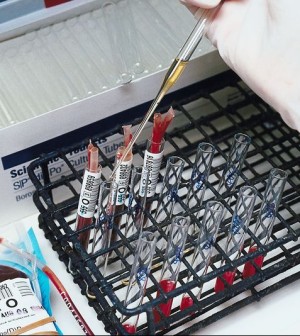- Bird Flu Virus in Canadian Teen Shows Mutations That Could Help It Spread Among Humans
- Flu, COVID Vaccination Rates Remain Low as Winter Nears
- ’10 Americas:’ Health Disparities Mean Life Expectancy Varies Across U.S.
- Short-Term Hormone Therapy for Menopause Won’t Harm Women’s Brains
- Could a Vitamin Be Effective Treatment for COPD?
- Woman Receives World’s First Robotic Double-Lung Transplant
- Flavored Vapes Behind Big Surge in U.S. E-Cigarette Sales
- Reading Beyond Headline Rare For Most on Social Media, Study Finds
- Meds Like Ozempic Are Causing Folks to Waste More Food
- Fibroids, Endometriosis Linked to Shorter Life Spans
Study Ties Inflammation, Gut Bacteria to Type 1 Diabetes

People with type 1 diabetes show changes in their digestive system that aren’t seen in people who don’t have the autoimmune disease, a new Italian study finds.
Those changes include different gut bacteria and inflammation in the small intestine. The differences may play a role in the development of type 1 diabetes, the researchers said.
“For years, we have looked for the cause of type 1 diabetes in the pancreas. Perhaps, we looked in the wrong place and there is the possibility that the intestines play a key role in the development of the disease,” said study senior author Dr. Piemonti Lorenzo. He is deputy director of the San Raffaele Diabetes Research Institute in Milan.
However, Lorenzo said it isn’t possible to “draw definitive conclusions” about whether these intestinal changes can cause the autoimmune attack that leads to type 1 diabetes.
In type 1 diabetes, the body’s immune system mistakenly attacks healthy cells in the body. Specifically, the disease causes the destruction of insulin-producing islet cells. That leaves the body unable to produce enough insulin, a hormone necessary for cells to use the sugars from foods as fuel.
Out of every 1,000 adult Americans, between one and five have type 1 diabetes, according to the Endocrine Society.
The new study included 54 people who had endoscopies and biopsies of the first part of the small intestine. In an endoscopy, a long, flexible tube with a camera is threaded down the throat — while a person is sedated — so a doctor can see the digestive tract. The same tube can be used to snip a small piece of the gastrointestinal tissue for a biopsy, according to the U.S. National Institute of Diabetes and Digestive and Kidney Diseases.
The study participants either volunteered for the study, or were already having the procedure to diagnose a digestive problem. The endoscopic procedures were performed at San Raffaele Hospital between 2009 and 2015.
Nineteen study participants had type 1 diabetes. Sixteen healthy study participants served as a control group. The last 19 had celiac disease, which is also an autoimmune condition. Celiac causes damage to the small intestine when gluten — a wheat protein — is consumed.
Lorenzo said up to 11 percent of people with type 1 diabetes also have celiac disease.
“The two diseases share something, but not all,” Lorenzo said. He added that in this study, no one with both conditions was included.
By using tissue samples taken from endoscopy, the researchers were able to directly assess changes in gut inflammation and digestive bacteria. They were also able to get high-resolution snapshots of the innermost layer of the gastrointestinal tract.
Previous studies have relied on stool samples to evaluate gut bacteria. Jessica Dunne, director of discovery research for JDRF (formerly the Juvenile Diabetes Research Foundation), said the composition of gut bacteria (microbiome) changes, depending on where you look in the digestive tract.
“As this paper suggests, the small intestine may be more relevant to type 1 diabetes,” Dunne said.
The study found that people with type 1 diabetes had significantly more inflammation in the mucous membrane of the gut linked to 10 specific genes than those with celiac disease or people in the control group.
The people with type 1 diabetes also showed a different and distinct combination of gut bacteria.
“We found big differences among the groups,” Lorenzo said.
“We think that our data add an important piece to disentangle the complex pathogenesis [biological triggers] of type 1 diabetes and, more generally, of autoimmune diseases,” he said.
If the findings are confirmed, this information might be used to develop a new treatment in people with a high risk of developing type 1 diabetes, Lorenzo said.
Said Dunne: “It’s an interesting finding that they were able to show these differences in the gut. It lends further credence to the idea that inflammatory processes are underlying diabetes. This warrants further examination.”
She added that JDRF has funded some similar studies, so if these results are replicated, it could lead to a “pretty significant advance in understanding these inflammatory processes.”
The study was published Jan. 19 in the Journal of Clinical Endocrinology & Metabolism.
More information
Learn more about type 1 diabetes from the Diabetes Research Institute.
Source: HealthDay
Copyright © 2024 HealthDay. All rights reserved.



-120x134.jpg)




